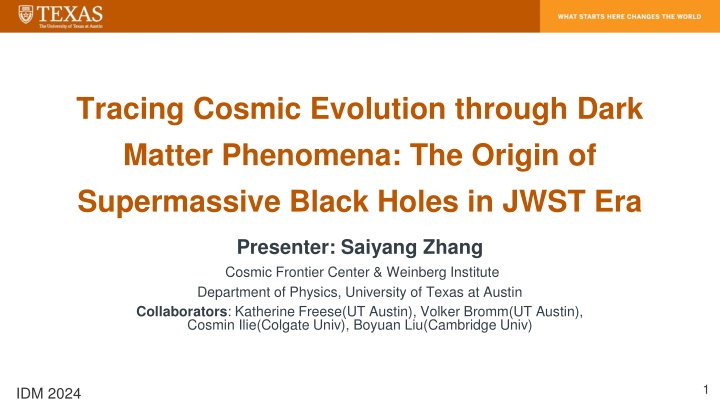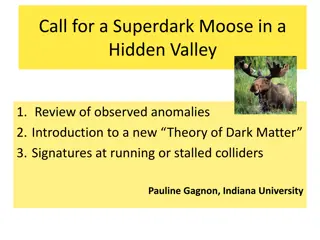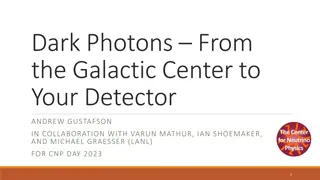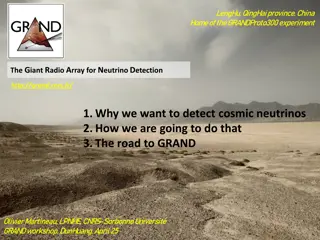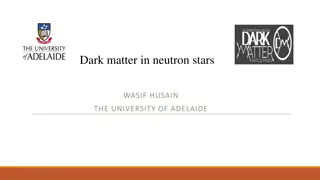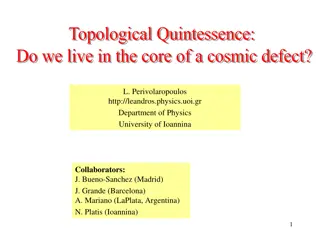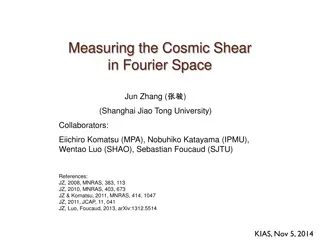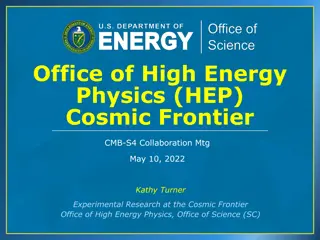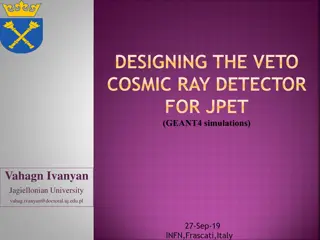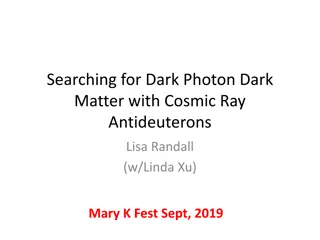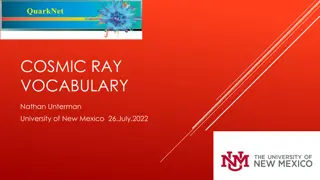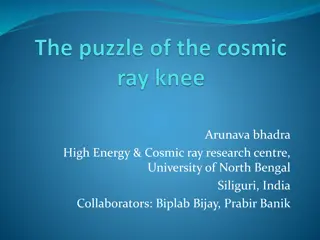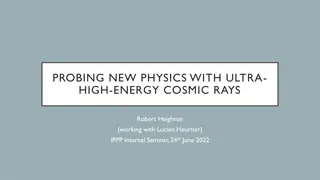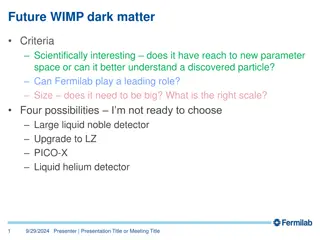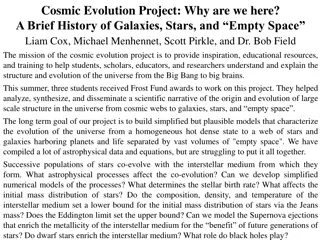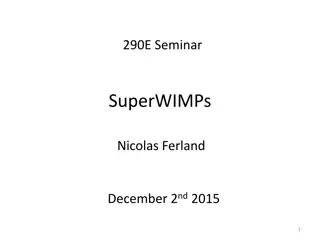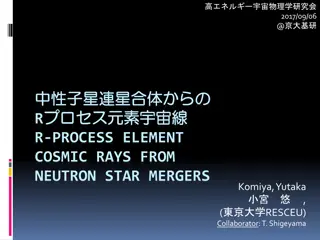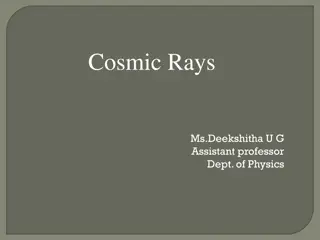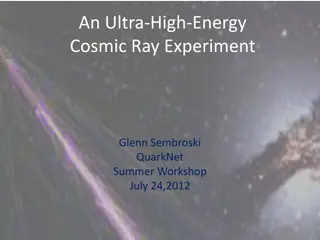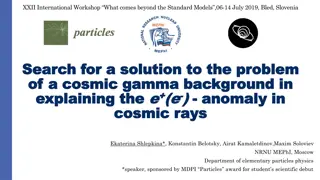Tracing Cosmic Evolution through Dark Matter Phenomena
Presenter Saiyang Zhang explores the origin of supermassive black holes in the JWST era, shedding light on SMBHs, their growth, Eddington limit, and implications for cosmology. The discussion delves into the role of dark matter, SMBH seeding, and the challenges posed to current cosmic structure theories by recent JWST observations.
Download Presentation

Please find below an Image/Link to download the presentation.
The content on the website is provided AS IS for your information and personal use only. It may not be sold, licensed, or shared on other websites without obtaining consent from the author.If you encounter any issues during the download, it is possible that the publisher has removed the file from their server.
You are allowed to download the files provided on this website for personal or commercial use, subject to the condition that they are used lawfully. All files are the property of their respective owners.
The content on the website is provided AS IS for your information and personal use only. It may not be sold, licensed, or shared on other websites without obtaining consent from the author.
E N D
Presentation Transcript
Tracing Cosmic Evolution through Dark Matter Phenomena: The Origin of Supermassive Black Holes in JWST Era Presenter: Saiyang Zhang Cosmic Frontier Center & Weinberg Institute Department of Physics, University of Texas at Austin Collaborators: Katherine Freese(UT Austin), Volker Bromm(UT Austin), Cosmin Ilie(Colgate Univ), Boyuan Liu(Cambridge Univ) 1 IDM 2024
Content Supermassive Black Holes (SMBHs): an overview Results from the latest JWST observations Beyond Standard Model physics on SMBH seeding 2 IDM 2024 Saiyang Zhang
Supermassive Black Hole (SMBH) Mass >106solar mass black holes Accrete surrounding material through gravity and form accretion disk Produce copious amount of X-ray emission, also a radio source Could be observed through emission line broadening (fast moving clouds) M87, Medeiros et al. (2023) [2304.06079] Saiyang Zhang 3 IDM 2024
Black Hole Growth and Eddington Limit https://www-astro.physics.ox.ac.uk/~garret/teaching/lecture7-2012.pdf 4 Smith et al. (2017) [1703.03083] IDM 2024 Saiyang Zhang
Light Seed vs. Heavy Seed in CDM Model Pop III star remnants Dense Star Cluster Direct Collapse Black Hole (DCBH) 5 Smith et al. (2019) [1904.12890] IDM 2024 Saiyang Zhang
James Webb Space Telescope (JWST) https://www.nasa.gov/image-article/james-webb-space-telescope-jwst/ IDM 2024 6 Saiyang Zhang
Questions on Cosmology from JWST Discovery Stress testing standard universe model (Boylan-Kolchin (2023) [2208.01611]) Discovery of too massive galaxies with stellar mass >109solar mass at high redshift z >10 Challenging current cosmic structure/galaxy formation theory and simulations Need new theory/models to explain, or over-prediction of stellar mass (Wang et al. (2024) [arXiv:2403.02399]) Early Supermassive Black Hole formation See next page 7 IDM 2024 Saiyang Zhang
Some Recent Discoveries from JWST Bodgan et al. (2024) [2305.15458] z=10 AGN: UHZ-1 8 IDM 2024 Saiyang Zhang
Co-evolution of SMBH with Galaxy Chicken or Egg? Silk et al. (2024) [2401.02482] Saiyang Zhang 9 IDM 2024
Beyond Standard Model Path Supermassive Dark Star (WIMP) (Massive) Primordial Black Holes (PBH) Self-interacting Dark Matter (SIDM, see tomorrow s planetary talk) 10 IDM 2024 Saiyang Zhang
About Dark Stars Formed in the center of mini-halo Powered by DM(WIMPs), no fusion reaction Capture DM to refuel Can grow supermassive to about ~107solar mass Collapse into massive black hole seed after fuel depleted https://www.sci.news/astronomy/webb- supermassive-dark-stars-12096.html Freese et al. (2008) [0802.1724] 11 IDM 2024 Saiyang Zhang
https://www.scientifica merican.com/article/jw st-might-have-spotted- the-first-dark-matter- stars/ 12 IDM 2024
Dark Stars Detectable by Roman Space Telescope (RST) RST have similar detection limit as JWST but have much wider field of view RST could detect supermassive dark stars up to z~14, and capable of distinguishing them from early galaxies by unique spectral features Lensing by foreground object can help us find less massive dark stars Zhang et al.(2024) [2306.11606] IDM 2024 Saiyang Zhang
Dark Stars Detectable by Roman Space Telescope (RST) Zhang et al.(2024) [2306.11606] No Lensing 100x Lensing IDM 2024 Saiyang Zhang
Primordial Black Holes Formation Gravitational Wave as a Probe https://phys.org/news/2021-03-gw190521-event- primordial-black-holes.html https://en.wikipedia.org/wiki/Primordial_black_hole 15 IDM 2024 Saiyang Zhang
Credit: https://kspa.soe.ucsc.edu/sites/ default/files/Lecture1_PN.pdf 16 IDM 2024 Saiyang Zhang
Lensing Evaporation Dynamical Friction Accretion & Gravitational wave Large-scale Structure 17 Fig 10: Carr et al. (2021) [2002.12778]
Primordial Black Holes and Structure Formation 106solar mass Primordial Black Hole candidate used in this work Primordial Black Holes will seed the formation of halos surrounding them Primordial Black Hole seeded halos will engulf newly formed neighboring halos Zhang et al. (2024) [2405.11381] 18 IDM 2024 Saiyang Zhang
Halo Dynamics in PBH Universe Zhang et al. (2024) [2405.11381] 19 IDM 2024 Saiyang Zhang
Zhang et al. (2024) [2405.11381] Saiyang Zhang 20 IDM 2024
In the Future Run more cosmological simulations with different initial conditions/scales for Primordial Black Holes Study how would different Primordial Black Hole candidates influence the formation of the first stars and galaxies Find more possible observational features from Dark Stars and Primordial Black Holes Data mining from available JWST dataset 21 IDM 2024 Saiyang Zhang
Summary In the era of deep sky surveys, we are closer to understand the formation of SMBH in early universe Early JWST results favor the heavy seed scenario Different astrophysical phenomenologies from beyond standard model DM could also form massive seeds to solve the problem involving supermassive black hole formation 22 IDM 2024 Saiyang Zhang
Thank you! Grazie! 23 IDM 2024 Saiyang Zhang
